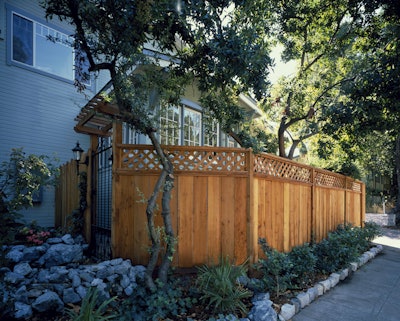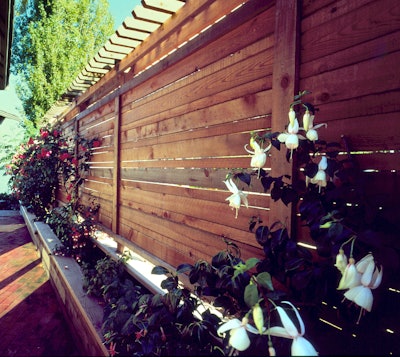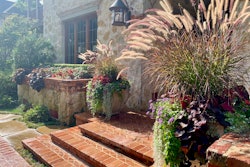
This doesn’t mean a fence has to be generic and bland. Depending on your client’s location, you can create a beautiful fence by opting to use redwood as your material.
“Redwood is the material of choice for fencing in California,” says Charlie Jourdain, manager of business development for Mendocino Forest Products / Humboldt Redwood. “It is widely available here because this is where it is sustainably grown and manufactured. It is naturally resistant to termites and decay, easy to work with and has a pleasing appearance.”
Pros and cons of fencing materials
If your client is trying to decide between redwood and other common wood fencing materials such as cedar, pine and cypress, here are some of the pros and cons of each.
Cedar is the go-to material for residential fences. It is resistant to rot and insects and has a desirable color. It does require regular maintenance, but well-maintained cedar fences have been known to last between 15 to 30 years, depending on the level of care. It is more expensive than other options like pine.
 Photo: Barbara Bourne
Photo: Barbara BournePressure-treated pine is the most affordable fencing material option, but it tends to have an unattractive appearance over time and is more susceptible to warping, twisting and shrinking. Pine fences tend to last 15 years or less, but with great maintenance it can last beyond this average lifespan.
Cypress is a popular alternative to cedar, especially in the Southeast where it is readily available. It is typically less expensive than cedar in this region. It does well in wet climates and is also rot and insect resistant.
Redwood is the high-end option when it comes to fencing material but is less expensive than tropical wood materials. It is naturally resistant to insects, decay and warping.
“A redwood fence will typically last 25 years or more with little or no maintenance,” Jourdain says. “Treated wood and cedar fences will begin to exhibit performance problems in half this time.”
The main drawback of redwood is its availability outside of California and some western states is pretty limited.
Fencing styles
If your client has decided they want to go with redwood for their fence, you next have to determine the design style and function of the fence.
Some of the questions to ask your customer should be, “What views do you want to keep or block?” “What needs to be protected from the sun or prevailing winds?” “What mood are you trying to convey?”
“Redwood fencing can use horizontal or vertical boards, ‘dog-eared’ or square or with a variety of other profiles and designs,” Jourdain says.
When it comes to fencing, don’t forget the zoning laws in the towns where you are working. Virtually all cities have fence height restrictions, and while some zoning codes consider latticework part of the fence, others don’t.
There are four main fence styles: lattice, picket, board-on-board and panel.

Board-on-board fencing is a good option that keeps neighbors in mind, as it looks the same from both sides. It can vary in height and provides good privacy and protection from the wind and sun.
Panel style fencing is your tried and true option that provides a solid barrier, but there are limited design options with this look. Alternating panels can provide some variety to the fence.
There are many other design variations from these four main styles, but once you know the look your customer wants, you can select the right redwood for the job. There are garden grades and architectural grades of redwood, which are suited for different functions.
Garden grades are knotty, rugged and economical. Architectural grades are better suited for decorative fences.
Garden grades include Construction Heart, Construction Common, Deck Heart and Deck Common, Merchantable Heart and Merchantable. Construction Heart has knots of a limited size and is good for posts, rails and fence boards.
Construction Common contains sapwood, which is visually dramatic on large fences. It works best in fence boards, trellises or gates. Deck Heart and Deck Common are similar to Construction Heart and Construction Common but are graded for strength.
Merchantable Heart has larger knots and knotholes and works well as fence boards, posts and rails in low fence projects. Merchantable has larger knots and knotholes and can be cut for rough or rustic fence boards.
 Photo: Barbara Bourne
Photo: Barbara BourneArchitectural grades are made of Clear All Heart, Clear, B Heart and B Grade. Clear All Heart has no knots of the best face. It can be used on or near the ground. Clear is knot-free and is good for architectural fence panel designs that are away from the ground.
B Heart allows limited knots and is 100 percent heartwood while B Grade has limited knots and contains sapwood. It should be used for above-ground applications.
Redwood can take and hold finishes considerably well, but do not apply varnishes, clear film-forming finishes, oil treatments and “shake and shingle” types of paint.
“Most people will actually never apply any type of finish to their redwood fence,” Jourdain says. “These fences will weather naturally to a pleasing driftwood grey color. Finishes such as semitransparent stains can slow the weathering process, alter the color to correspond to the house or other architectural elements and increase the longevity. These types of stains need to be reapplied every five years or so. Redwood fences can also be painted for a solid color appearance and to maximize protection from the weather.”










